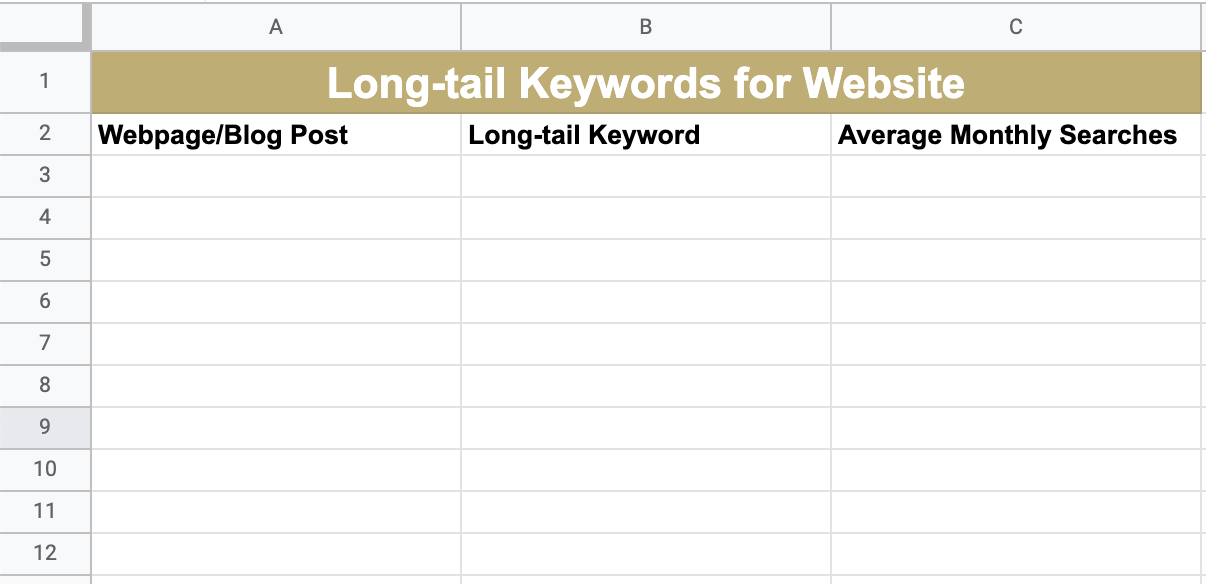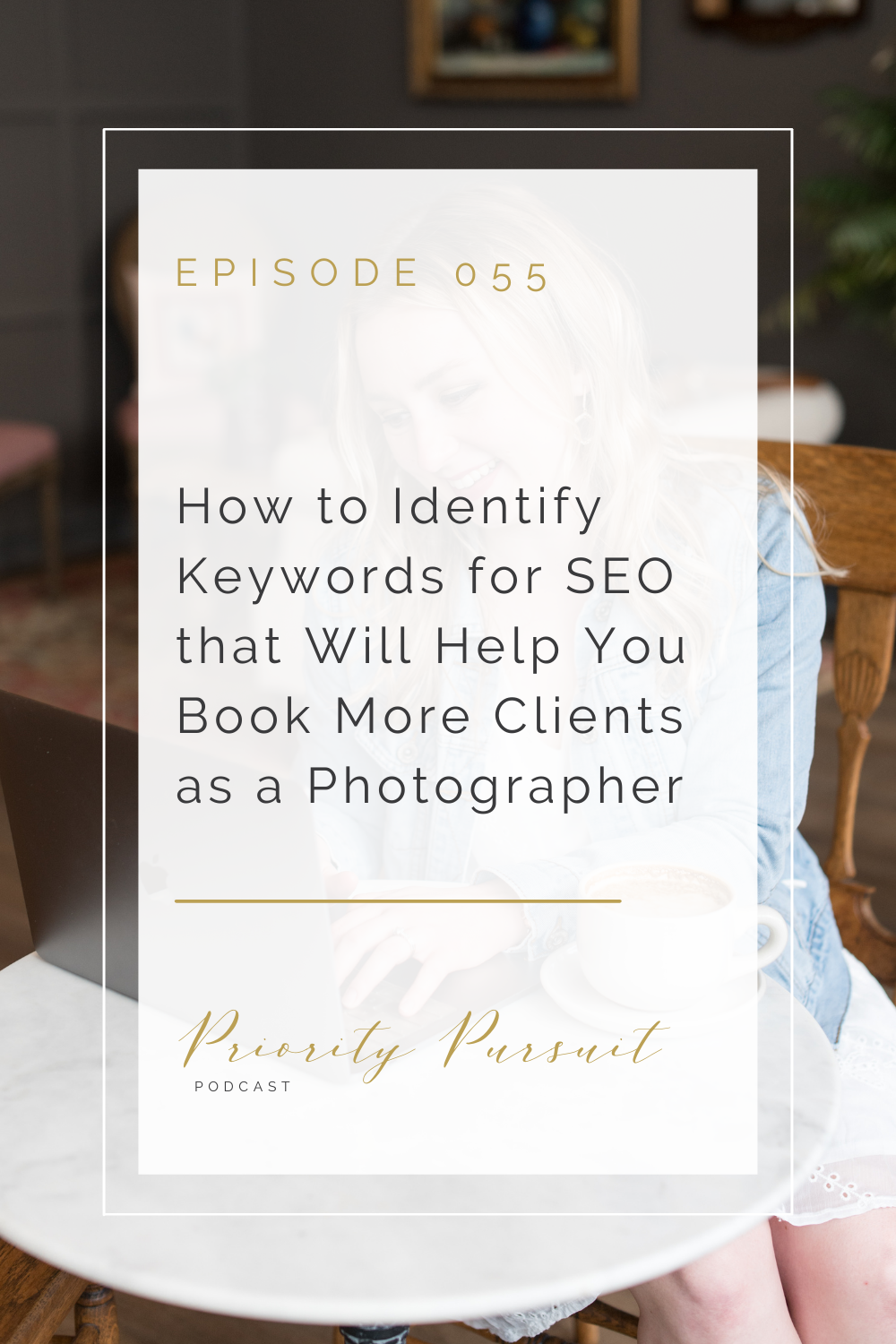Let's Connect!
Check Out Wedding Photography Packages]
I understand how much your wedding photos mean to you and how much work you’re putting into planning every last detail of your big day. As a VRP bride, you can relax and enjoy your wedding day knowing you’ve chosen a team of photographers who are just as detail-oriented as you are, will put thought into every shot, and will pay attention to all of the little details to ensure that you and your spouse love your wedding photos.
And, I’m an Indy wedding photographer for the type-A bride.
I'm Victoria Rayburn
Hey there!
Episode 055: How to Identify Keywords for SEO that Will Help You Book More Clients as a Photographer
Spotify | Apple Podcasts | Stitcher
Are you a photographer wanting to improve your SEO? Have you heard that you need to identify strategic keywords, but you either (1) have no idea what that means or (2) aren’t sure how to identify keywords for your website or what to do with them?
If so, this episode of Priority Pursuit is for you, my friend! Because, today, we’re discussing how to identify keywords for SEO that will help you book more clients as a photographer.
Are you another kind of creative entrepreneur looking for keyword help?
Usually, Priority Pursuit episodes are for all creative entrepreneurs; however, this episode is specifically for photographers so that we can dive deep into a keyword strategy that works well for photographers.
If you’re another creative entrepreneur and would like to learn more about how you can identify and optimize your website with strategic keywords, be sure to tune into “Episode 009: How to Identify & Use Strategic Keywords to Improve Your SEO.”
How to Identify Keywords for SEO that Will Help You Book More Clients as a Photographer
Photographers friends, I’m so glad you’re here! Because, the fact that you’re reading/listening to this episode means you’re ready to talk about one of my favorite subjects—search engine optimization.
If you’ve tuned into past episodes of Priority Pursuit, you know that I’m crazy passionate about this subject, because SEO has played a HUGE role in my business. In fact, every year, approximately 40% of my couples find me through Google—meaning SEO is responsible for 40% of my income every year.
In my opinion, SEO is one of the most effective marketing tactics, because SEO allows you to get your products, services, and content in front of potential customers who are actively looking for what you have to offer. Plus, while it does take upfront work to understand SEO and optimize your site for search engines, SEO is FREE!
That said, I know SEO can be intimidating. When I talk to other photographers about SEO, most say that they know SEO is important and powerful but they have no idea where to start.
Truthfully, there are a lot of moving parts to SEO—many of which we’ve covered in past episodes—but once you understand the basics, there’s no reason you can’t handle your own SEO strategy. And, understanding how to identify strategic keywords and optimize your website with them is one of the most effective ways to improve your SEO, which is exactly what we’re going to discuss today.
What are keywords, & how do they help searchers find your content?
Before we talk about how to identify them, we need to discuss what keywords are.
Moz defines keywords as, “Ideas and topics that define what your content is about. In terms of SEO, they’re the words and phrases that searchers enter into search engines.”
As a photographer, you want to include relevant keywords on your webpages and in your blog posts so that your ideal clients will find your website when they’re searching for your services—even if they’ve never heard of you specifically.
Basically, your goal should be to include keywords on your website that mirror what people are searching and to provide content that is helpful and relevant so that your website can become a reliable online resource that Google trusts. When Google trusts your website, it will be more likely to rank your website well, allowing searchers to easily find your services when they need them.
You want to optimize your webpages & blog posts with long-tail keywords—not head keywords.
Now, a common mistake that photographers make is optimizing their websites for broad keywords (head keywords) instead of specific keywords (long-tail keywords).
We’ll discuss the difference between head and long-tail keywords, but basically, it’s important to understand that it will be much easier and more beneficial for your website to rank for long-tail keywords than for head keywords.
What are head keywords?
Broad keywords—also called “head keywords”—are usually one or two words. For a wedding photographer, examples of head keywords might include “wedding photographer,” “photographer,” “wedding photos,” “engagement photographer,” and other broad words that describe a wedding photographer’s services in general.
Head keywords have high search volumes, so it’s a common mistake for people to think that these are the keywords they should be using to optimize their websites. But, this is not the case, especially for small businesses.
We’ll stick with our wedding photographer example. The average wedding photographer won’t be able to rank on the first page of a Google search for “wedding photographer” (a head keyword) because there are so many photographers in the world with websites. (The exception is local search—results that Google shows based on your location when you type in a search query).
Right now, if you Google “wedding photographers,” 561,000,000 results appear. That’s a lot of online competition! And, to be honest, it’s practically impossible for even a world-renowned wedding photographer to overcome these numbers and make his or her way to the first page of Google search.
So, how do you combat this? You need to optimize your website with long-tail keywords that your ideal clients will be searching for.
What are long-tail keywords?
Long-tail keywords are more specific keywords—ideally made up of four or more words (three words work occasionally)—that better mirror a searcher’s intent.
Long-tail keywords are more powerful than head keywords because, according to Neil Patel, “Long-tail keywords are how people actually search the internet.”
Think about when you search for something. Do you type in one or two words? No. You type in a question or add a description so you can find results that are more relevant to what you need.
Examples might include “best gluten-free pizza near me” or “substitute for sesame oil.” In fact, 70% of all Google searches are specific like these examples.
Now, let’s pretend that you’re a wedding photographer in Indianapolis and that your target audience is brides in the Indianapolis area. You don’t need to rank well for “wedding photographer.” Instead, you need to rank well for searches that are relevant and specific to your target audience. These searches might include “Indianapolis wedding photographers,” “wedding photographers in Indianapolis,” or “light and airy wedding photographers in Indianapolis.”
These long-tail keywords are more specific to your target audience and have less competition, meaning you’re more likely to rank well. For example, only 3,830,000 results appear when you search “Indianapolis wedding photographers.” This seems like a lot, but it’s significantly less than the 561,000,000 results that appear for “wedding photographer”!
Basically, according to HubSpot, long-tail keywords offer you the path of “least resistance” and are more likely to put you in front of your target audience.
When choosing long-tail keywords, there are a few “rules” you need to follow.
We’ll get into how to choose long-tail keywords for every web page and blog post in a minute, but before we do, here are a few rules or best practices that are important to note:
- You need a long-tail keyword for every webpage and blog post you want search engine users to be able to find.
- Every webpage and blog post needs a different long-tail keyword. You cannot use the same keyword on more than one page.
- Your long-tail keyword needs to be relevant to the page you’re using it on. If your keyword isn’t relevant, search engines will see this, and your search ranking may be
- Long-tail keywords have four or more words. You can occasionally use three words.
- Your long-tail keyword should have between 1-100 searches per month. This helps ensure that your website appears when people are specifically looking for your products or services. If your market is saturated, you can occasionally get away with 100-1000 searches.
As you’re choosing your long-tail keywords, be sure to refer to this list. Now, let’s talk about actual steps and tools you can use!
1. Create a spreadsheet so you can keep track of which long-tail keyword goes with which web page or blog post.
We’ll discuss how to identify strategic keywords for blog posts later on, but for now, let’s focus on how you can identify strategic long-tail keywords for the main pages of your website. And, this is going to require you to start with a spreadsheet.

Make a spreadsheet with three columns: one to list all of your webpages, one to list each page’s coinciding long-tail keyword, and another to list each keyword’s average monthly searches. Go ahead and add all of your webpages (home, about, services, etc.) to the first column.
While you’ll likely put up or update all of your webpages at once, you will (or at least you should) be adding blogs and other content to your website on a regular basis. So, every time you add something new, you’ll want to return to this spreadsheet to:
- Make sure you haven’t already used a long-tail keyword.
- Add the new blog post or page and its long-tail keyword so you have a record that you can easily refer to as you add new content to your site.
2. Think about your ideal client’s search intent & use common sense & online tools to brainstorm a list of possible long-tail keywords.
Next, you want to think like your ideal clients and about their intent so that you can determine what keywords you should be optimizing your website for. What are they searching for? What do they need from you? Is your location or service area important? What’s important to your ideal clients when they’re looking for a service like yours?
With long-tail keywords, user intent is very important, because your goal is to get your website in front of the individuals who need your services or your content. So, start by using common sense to brainstorm a list of keywords that you think might be relevant.
We’ll stick to our example of pretending you’re a wedding photographer in Indianapolis. But, we’ll add that you have a light and airy style. Some possible long-tail keywords that come to mind right away are: “wedding photographer in Indianapolis,” “Indianapolis wedding photographer,” “light and airy wedding photographer in Indianapolis.”
Free Keyword Tools
After you’ve used common sense to get your list started, use SEO tools to find more possible long-tail keywords. There are several great SEO tools, but most require an expensive membership.
However, in most instances, you can find keyword ideas and data on the Internet for free.
When I need keyword ideas, I use the following free tools:
- The Google AdWords Keyword Tool
- The Keyword Tool
- Moz’s Keyword Explorer (The free version allows you to explore 30 searches per month.)
- The “Related Searches” section on Google
- Google’s dropdown suggestions
3. Use Google AdWords’ Keyword Planner to check the average number of searches per month for each long-tail keyword.
Once you have a list of possible long-tail keywords, it’s time to determine which are most effective based on data.
Using Google AdWords’ Keyword Planner, type in each possibility (while paying attention to other options that populate) and look at the long-tail keyword’s average number of monthly searches (in the “Avg. monthly searches” column).

The most strategic, niche long-tail keywords will have between 1-100 search per month. That said, if you’re a photographer in a competitive market, you may have to settle for 100-1000 searches per month. And, if you’re in a very competitive market—such as New York City—you may need to make your long-tail keywords even more specific to niche down further—such as a adding your photo style to your long-tail keyword (e.g. “dark and moody wedding photographer in NYC) or other information that’s pertinent and likely to be searched by your ideal client.
Like we talked about before, it sounds like a good idea to look for keywords that have thousands or millions of searches per month, but that isn’t the case. Remember, your goal is to get your website in front of people who are actively looking for the service you offer in your service area.
As you determine which keywords are strategic, cut your brainstorming list down until it only contains keywords that meet the criteria we’ve discussed and align with your business goals.
Please Note: Google may not have data for all long-tail keywords. While Google knows almost everything, it does occasionally fall short. If you’re convinced that a long-tail keyword will work but Google’s Keyword Planner will not display the long-tail keyword, or the average number of searches aren’t available, don’t panic.
Instead, type your long-tail keyword idea into a Google search and see what appears. If you want your business listed with the results that appear (maybe competitors show up), you likely still have a good long-tail keyword choice. It’s probably just so specific or niche that Google doesn’t have the data you’re looking for.
4. Identify a relevant long-tail keyword for each web page.
Once you have a list of possible long-tail keywords that are intentional and have the data needed to back them up, start identifying long-tail keywords for each webpage that are relevant.
In this case, relevant means that there is a connection between each page and its long-tail keyword. Some people assume that if they simply use a long-tail keyword on a page, the page will rank well. However, if your long-tail keyword does not relate to the content on the page, search engines may punish you by giving you a lower ranking.
For example, if you have a webpage about family photography but make your long-tail keyword “best wedding photographers in Indiana” because you’re trying to increase your search engine rankings as a wedding photographer, your long-tail keyword is not relevant to your webpage.
So, work your way through your spreadsheet and determine which long-tail keywords work best for each page, and record the keyword’s average number of monthly searches.
How do you identify long-tail keywords for blogs and other content?
While your service-specific keywords (the long-tail keywords people search when they’re in need of your services) should be used on your website’s main web pages, you also need a keyword strategy for blog posts.
As a photographer, it’s a good idea to write two kinds of blog posts from an SEO perspective: educational blogs (many of which can be location-specific) and blogs that feature photos from sessions.
Long-tail Keywords for Educational Blogs
Educational blogs are blogs that answer your ideal clients’ questions, making you a helpful resource. These posts help build your authority and are particularly helpful in improving your search engine rankings, because educational blog posts are likely to be visited (assuming you share them), and if your content is helpful, educational blog posts keep visitors on your site for a long periods of time, which is also helpful for SEO, because this shows Google people are finding your content helpful.
In case this helps, here’s an example. If you’re a wedding photographer, you could write a blog about why to consider a first look on your wedding day. After doing SEO research, you might conclude that “why you should do a first look on your wedding day” would be a great long-tail keyword, as it’s a term that’s niche but likely to be searched.
While I absolutely recommend writing blog posts about anything and everything that’s helpful to your ideal client, writing and optimizing educational blog posts that are specific to your location can be particularly valuable for SEO, because (1) Google will start to further associate your website with your service area and (2) your ideal client is likely searching for location-specific content as he/she plans a wedding or thinks ahead for family photos.
For example, when we moved to Indianapolis, one of the first blog posts I wrote was about the best locations for engagement photos in Indianapolis. This blog post features about 15 locations in Indy that I love shooting at, and the long-tail keyword for the post is “best places to take engagement photos in Indianapolis.” According to my research, this is something that is likely to be searched, making it helpful to my potential customers. Plus, this is now a blog post I can easily share with my own clients as they decide where to take their engagement photos.
We can only cover so much in a single episode, but blogging educational content—especially location-specific content—is very beneficial. And, if you need some topic inspiration, be sure to check out our free guide “75 Blog Topic Ideas for Photographers”!
Long-tail Keywords for Session & Wedding Blogs
In addition to blogging educational content, it’s also so important to blog shoots and weddings. This helps potential clients see your work, and blogging sessions and weddings will drastically improve your SEO.
When you blog sessions and weddings, I highly recommend using location-specific long-tail keywords, meaning I recommend making your long-tail keyword for the page specific to the wedding venue or wherever you shot the photos.
This is going to help get your blog posts in front of people who are considering having their photos taken at the same location, and this could potentially lead to bookings for you.
For example, let’s say you shot an engagement session at Purdue University. Your long-tail keyword for that session blog post could be “Purdue University engagement photos” or “engagement photos at Purdue University.”
Either option describes what the particular blog post is about and is likely to be searched. In fact, I’ve booked several weddings because several of my Purdue engagement blog posts rank well, and these blog posts are how clients found me as they looked for inspiration for their own engagement photos at Purdue.
After you’ve identified long-tail keywords for your website, what do you do with them?
While beautiful spreadsheets are nice, it isn’t enough to just have a list of keywords that could be helpful. You have to get these keywords on your website.
With this in mind, where should your long-tail keywords go? And, friend, I’d love to show you! If you download “A Guide for Photographers: How to Identify Keywords for SEO that Will Help You Book More Clients,” you’ll be given both screenshot examples of everything we’ve discussed in this episode, as well as step-by-step instructions on where to put your long-tail keywords on your website.
Want even more SEO help?
While we’ve covered a lot of SEO information on Priority Pursuit and there are a lot of really great SEO resources available online, if you’re ready to take SEO more seriously, I can’t help telling you about two further educational opportunities—one of which is available now and the other will be available very soon!
Register for one-on-one SEO coaching for photographers!
First, I do offer SEO coaching for photographers. SEO coaching includes up to five hours of one-on-one coaching with me where we’ll go over the 14 things you need to do to improve your search engine rankings and map out a content marketing strategy specific to your goals.
Oh, and with SEO coaching, I do the keyword research for the main pages of your website for you!
If this sounds like something you’re interested in, learn more about SEO coaching for photographers!
Join the waitlist for the coming SEO for photographers online course!
If one-on-one coaching isn’t for you, I am very excited to share that in the next few months, I’ll be releasing an online SEO course for photographers. Details are still in the works, but this course will cover everything I share in SEO coaching sessions, meaning you’ll have all of the information you need to optimize your website for search engines all on your own. If you’d like to be the first to find out when this course launches, join the waitlist!
I know this episode was a long one, but thank you for hanging out until the very end. SEO has done huge things for my business, and I’m passionate about it, because I know it can do big things for your business too.
Again, SEO is one of a few ways you can get your content, products, and services in front of those actively looking for what you have to offer. And, as a result, I think all photographers should make SEO a top business priority.
Links & Resources Mentioned in This Episode
“Episode 009: How to Identify & Use Strategic Keywords to Improve Your SEO”
Tune Into Other Priority Pursuit SEO Episodes
Receive 50% Off Your First Order with Photographer’s Edit
Save $50 on Your First Order from KISS Books of $100 or More
Receive $20 Off Your First Pair of Rothy’s
Join the Priority Pursuit Facebook Community
Follow or DM Victoria on Instagram
Did you enjoy this episode? If so, pin it to save it for later! Follow me on Pinterest for more marketing, business, branding, and boundary-setting strategies!

Let's Connect!
Check Out Wedding Photography Packages]
I understand how much your wedding photos mean to you and how much work you’re putting into planning every last detail of your big day. As a VRP bride, you can relax and enjoy your wedding day knowing you’ve chosen a team of photographers who are just as detail-oriented as you are, will put thought into every shot, and will pay attention to all of the little details to ensure that you and your spouse love your wedding photos.
And, I’m an Indy wedding photographer for the type-A bride.
I'm Victoria Rayburn
Hey there!
© 2023 Victoria Rayburn Photography. All rights reserved. | Terms & Conditions | Privacy Policy
Let's Connect!
@victorialrayburn
Let's Connect! | @victorialrayburn
Schedule a Coffee Date
However, as a VRP bride, you can relax and enjoy your celebration while being confident that every moment and detail is being thoughtfully photographed!

